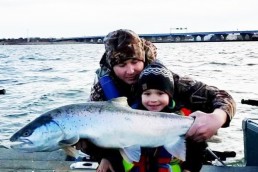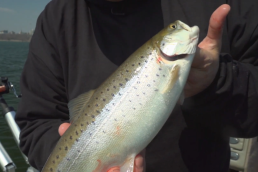Lake Michigan Shore Fishing
SHARE THIS POST
Inshore Boat Tactics
Options for near-shore fishing in small boats
In the last 10 years, many anglers have realized that you don’t need a 40-foot boat and two thousand dollars worth of gear to take advantage of the great trout and salmon fishing on Lake Michigan. Beyond shore fishing, if you have a seaworthy inland boat in the 14- to 17-foot range, you are ready to go if you use caution.
That’s topic is an article in itself, but the bottom line is, watch the weather. Avoid onoshore winds of more than 10 mph, don’t go when any wind changes are expected, and of course do not go out when any chances of storms are in the forecast. Also, all the boat and passenger requirements for a large boat on the Great Lakes are also required for a small boat. This includes handheld flares or a flare gun.
So, I’m not a big fan of trolling, but it’s a lot of water and a necessity at times, at least to get started. For small boat inshore fishing, you don’t need downriggers, Dipsey Divers or even planer boards. Those items are personally the reasons why I don’t like trolling out there, but you can be very effective without all the gear and the expense.
I start out trolling as a searching tool to either locate fish or schools of bait. If you are fishing in or around harbors, the depths that you are searching out are 20 to 30 feet, and you can cover that with deep-diving lures, flatline-trolled on a medium-heavy baitcasting rod.
A 7- to 8-foot rod designed for casting bass crankbaits is all that is needed. Rods that were sold as “flippin’” rods are perfect for harbor and near-shore trolling. If you are using braid on your baitcaster, use an 8- to 10-foot length of 12-pound clear mono ahead of the lure. It’s up to you, but I prefer trolling one lure per person and holding the rod in hand. It allows you at add action to the lures by pumping the rod forward and then dropping back. I can’t tell you how many hits come right after you drop a bait back during the troll and then reengage with it.
One of the best harbor trollers I ever knew was the late “Musky Marv” Peterson. He was a small boat master in the Milwaukee harbor. Marv would troll two lines. One was a sinking lure like a spoon; the other was a floating/diving lure like a deep-diving crankbait. Marv would take the boat out of gear for literally 15 seconds at a time. The spoon would sink and the crankbait would rise. When he put the motor back in gear, he could almost call the strike, triggered by a sudden change in lure direction.
Great lures for trolling 100 feet behind the boat on a flatline would be Deep ThunderSticks, Bandit Walleye Deeps, Smithwick Perfect 10s, Rapala Tail Dancers and Rapala DT14s.
Trolling for me is just a search tool. I’m certainly hoping to get bit, but more importantly I’m watching the locator, looking for “hooks” or pods of bait, because my ultimate goal is to stop and cast or drift for them.
Are you enjoying this post?
You can be among the first to get the latest info on where to go, what to use and how to use it!
One of the staples for deep harbor jigging has been the 4-inch white Gulp Minnow on a bullet head jig. It’s still a great option. Three-eighths or 1/2-ounce heads will cover most harbor or inshore areas that are less than about 30 to 35 feet deep. That’s about the deepest you will encounter in harbors. If a harbor takes shipping vessels, it is usually 27 or 28 feet deep in the shipping lane.
Blade baits are another staple of the jigging crowd. They can be bomb cast or worked vertically under the boat. The hard flash and vibration are very attractive to both trout and salmon.
Jigging spoons in the 1/2- to 3/4-ounce class are great tools for inshore salmonids. They too can be either worked vertical under the boat or long casted.
Another spoon that really has held its own with the near shore crowd is the Krocodile spoon. It’s more of a casting spoon, but it works great as a jigging option as well. The 5/8- or 3/4-ounce versions seem to be everyone’s favorites. This spoon has a very slow, tantalizing action on the fall that kings can’t resist.
Now, we get to my favorite, the pearl white tube jig. It’s so versatile and so easy to fish. Bomb cast it through bait or even just vertically jig it. If there is wind, I have done well just drifting it and slowly pumping the bait up and down. Catch a drift that will take you through or near baitfish, and work the water column where you see bait, or just below.
Speaking of drifting, a live alewife is a great drifting bait. Find a bait pod and drop one down with a gold hook above a jigging spoon or weight. Catch a half-dozen live alewives and keep them fresh in a livewell or bait bucket. You can use the same slip sinker rig that you would use from shore, except you will drop the weight to the desired depth like a poor man’s downrigger. Nose-hook the alewife so it swims along naturally. A 1.5- to 2-ounce weight is usually necessary to work the 15- to 25-foot levels.
Small boats have their place in the near-shore Lake Michigan fishery. Use caution and common sense when boating big water in a small vessel, but it can be done. Trolling the big waters is very effective, but I’ll take the thump of a big brown on a tube jig any day.
MWO
SHARE THIS POST
Did you enjoy this post?
You can be among the first to get the latest info on where to go, what to use and how to use it!
Marc Wisniewski
Marc Wisniewski is an avid Wisconsin angler specializing in Lake Michigan shore and inshore fishing. He also chases bass, pike, and muskies anywhere he can. He has built custom rods for 35 years and makes lures from wood, lead and soft plastics. Wisniewski has been writing fishing articles for more than 30 years.


